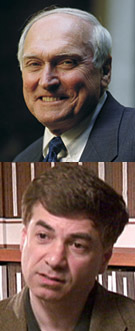
Two University of Notre Dame faculty members have been named fellows of the American Association for the Advancement of Science (AAAS) in honor of their efforts to advance science or its applications.
AAAS, founded in 1848 as a nonprofit association, is the worlds largest scientific society and publisher of the prestigious journal Science. The new Notre Dame AAAS fellows are James L. Merz, Frank Freimann Professor of Electrical Engineering, interim dean of the College of Engineering and former vice president for graduate studies and research at Notre Dame, and Shahriar Mobashery, Navari Family Professor of Life Sciences.
Merz, who joined the Notre Dame faculty in 1994, was cited fordistinguished contributions to the field of photonic devices and particularly to optical spectroscopy of semiconductor nanostructures.
Mobashery, a member of the Notre Dame faculty since 2003, was cited forcreative work on antibiotics and the mechanism of antibiotic resistance in bacteria, especially for contributions on methicillin-resistant Staphylococcus aureus, a clinical scourge.
A 1959 graduate of Notre Dame, Merz returned to his alma mater in 1994 to direct a team of researchers investigating Quantum Cellular Automata, a revolutionary new circuit technology that could power computers thousands of times faster and more capable than anything now available. The project was funded by a $3.45 million federal grant from the Defense Advanced Research Projects Agency.
An internationally recognized scholar in the field of optoelectronic materials and devices, Merz formerly was professor of electrical engineering, professor of materials and director of the Center for Quantized Electronic Structures (QUEST) at the University of California at Santa Barbara. In addition to directing QUEST, a National Science Foundation (NSF) science and technology center, he also chaired the national council of directors of the NSF science and technology centers. He has published 470 papers and holds five patents.
Also while at UC-Santa Barbara, Merz at various times chaired the Department of Electrical and Computer Engineering and served as associate dean for research of the College of Engineering and associate vice chancellor of the university.
Merz was graduated from Notre Dame with a bachelors degree in physics and attended the University of Göttingen in Germany as a Fulbright Fellow in 1959-60. He attended Harvard University as both a Woodrow Wilson and Danforth Fellow, earning his masters degree in 1961 and his doctorate in 1967. He joined the technical staff of Bell Laboratories in 1966 and conducted investigations there into the optical properties of compound semiconductors. After a semester as Gordon McKay Visiting Lecturer on Applied Physics at Harvard in 1972, he returned to Bell Laboratories, where he worked on optoelectronic devices and integrated optical circuits until joining the UC-Santa Barbara faculty in 1978.
A world-renowned expert in antibiotic resistance and enzyme inhibitors, Mobashery joined the Notre Dame faculty after previously serving as a professor of chemistry and the Charles H. Gershenson Distinguished Faculty Fellow at Wayne State University. His research interests encompass studies of mechanisms of resistance to antibiotics and the means to circumvent them, development of novel antibiotics, studies of the mechanism of action of these antibiotics, and investigations of complex microbial systems such as the outer membrane and the cell wall.
In addition, Mobashery and his research group are interested in the molecular mechanism of cancer metastasis and its intervention by rational design of molecules that interfere with the growth and spread of tumors.
Mobashery earned bachelors degrees in biological sciences and chemistry from the University of California in 1980 and 1981. He completed a doctorate in chemistry in 1985 at the University of Chicago. Subsequently, he conducted postdoctoral research at Rockefeller University from 1986 to 1988 as a National Institutes of Health postdoctoral fellow before joining the Wayne State faculty in 1989.
He serves on numerous governmental and industrial panels, as well as on the editorial boards of eight scientific journals. He has published more than 200 scientific papers and holds eight patents.
The tradition of AAAS fellows began in 1874 and this year the association is honoring 471 members as fellows. Currently, members can be considered for the rank of fellow if nominated by the steering groups of the associations 24 sections or by any three fellows who are current AAAS members (so long as two of the three sponsors are not affiliated with the nominees institution) or by the AAAS executive officer.
Merz and Mobshery will be presented with an official certificate and a gold and blue (representing science and engineering, respectively) rosette pin on Feb. 16, at the Fellows Forum during the 2008 AAAS annual meeting in Boston.
TopicID: 25186